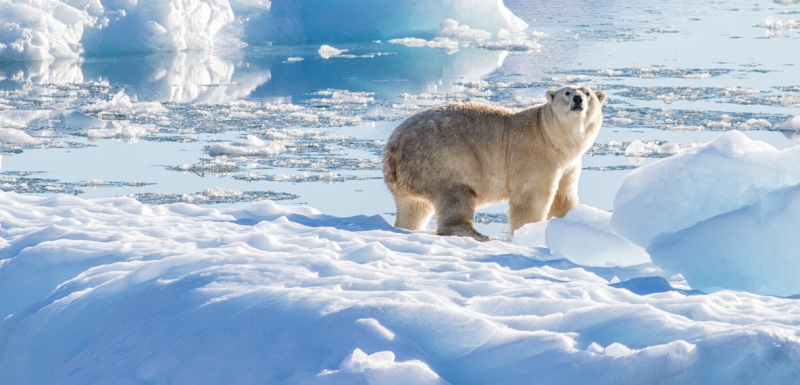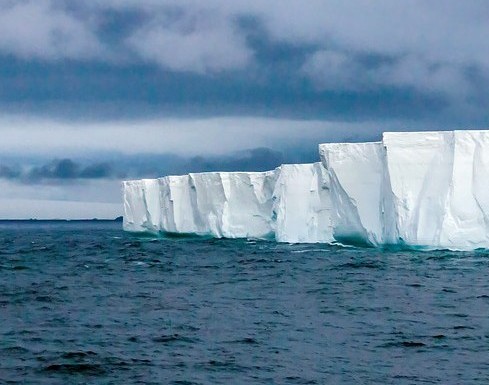
Think about the following questions.
1. What do you know about global warming?
2. How is the water supply in your country? What would happen if there were a shortage of water?
3. Are there glaciers in your country? Have you ever seen one?
VOCABULARY PREVIEW
Match each New Academic Word List(NAWL) word with the correct definition.
- ecology
- continent _____
- equilibrium _____
- conserve _____
- displacement _____
- emission _____
- a. one of the Earth's major land masses
- b. a state of balance
- c. the movement of something as a result of an outside force or circumstance
- d. something produced or given off, especially a gas or radiation
- e. to use carefully in order to prevent loss or waste
- f. the interactions between living things and their environment
GLACIER RETREAT

Global temperatures are rising as a result of carbon emissions that trap greenhouse gases in the atmosphere. And glaciers-large masses of ice at the Earth's poles and high up in mountain ranges are particularly affected by this global warming. The higher temperatures not only cause the glaciers to melt, they reduce the snowfall as well. Glaciers are formed when snow falls on existing snow, and the lower layer of snow is compressed1, creating a large mass of ice. If some of the surface of the glacier melts during warmer weather, that's OK as long as more snow falls to replace what was lost. But continually warmer temperatures mean that more ice is melting and less snow is falling. As a result, the glacier cannot sustain its mass; in other words, it shrinks2. We call this phenomenon "glacier retreat" because as its mass gets smaller, it seems to be retreating3 from landmarks.
Why do retreating glaciers have scientists and environmentalists so concerned? First of all, most of the Earth's supply of fresh water is found in the form of glaciers. The normal melting of glaciers during seasons of warmer temperatures provides fresh water to people, animals, and plants. If the glaciers are not able to sustain their mass, there will be less fresh water available for people to drink and use for raising crops. This could spell disaster for human populations around the world. Countries on every continent, including the US, China, India, and several eastern African nations, are already struggling to conserve water in the face of serious droughts. A reduction in glacier-fed river levels could be disastrous.
Furthermore, while the disappearance of glaciers would mean diminished fresh water supplies, the process of this disappearance is causing floods and rising ocean levels. Most glaciers are located at higher elevations because of the colder temperatures found there. So when the ice melts, gravity propels4 the water downward via rivers and streams. More melting means more water is entering the river system, which may be unable to bear the increased volume, resulting in flooding.
Flooding, in turn, destroys property and crops and disrupts the equilibrium of ecosystems. Once the water reaches the sea, it raises the water level, threatening coastal settlements. In addition, seawater can get into the ground water supply, further diminishing fresh water supplies as the seawater contaminates5 the fresh water with salt. Floods and rising water levels are forcing people to move, and the trend is expected to continue.
In addition to destroying settlements and causing the displacement of thousands of people, the melting of glaciers can destroy the farms that once relied on them for irrigation— the movement of water for crops. This presents a looming6 problem for the world's food supplies, as the disappearance of arable7 land places extra pressure on resources that are already threatened by rising populations. Furthermore, the disruption to ocean ecology affects fish and other animals. For example, corals8 rely on sunlight, and as the water level rises, their exposure to sunlight decreases. Fish that feed on the corals face reduced food supplies, and their numbers decline, adversely affecting the other fish, birds, and mammals that feed on them—including humans.
The accelerated loss of glaciers, itself caused by global warming, also compounds9 the effects of global warming. Glaciers absorb about twenty percent of the sun's heat and reflect the rest back. But when they disappear, the earth below gets exposed, absorbing eighty percent of the sun's heat and only reflecting twenty percent back. So the Earth's temperature increases, making the problem worse. Projections for the future are worrying since demand for water is expected to increase as the population grows and temperatures rise. Glacial retreat is thus one of the most pressing environmental problems we face today.
New Academic Word List
- compress 1 : v. to press or squeeze something so that it becomes smaller
- shrink 2 : v. to become smaller
- retreat 3 : v. to move back
- propel 4 : v. to push
- contaminate 5 : v. to make dirty or impure by adding something harmful
- looming 6 : adj. close to happening
- arable 7 : adj. suitable for farming
- coral 8 : n. a tropical sea animal that lives in colonies and whose hard skeletons form reefs
- compound 9 : v. to make something worse
READING COMPREHENSION
A ‣ Mark each statement as true (T) or false (F) according to the reading.
- Glaciers consist of layers of snow packed into ice.
- True
- False
- Some melting of glaciers is normal and necessary.
- True
- False
- Retreating glaciers are beneficial for farmers.
- True
- False
- Rising sea levels negatively affect coral.
- True
- False
- Glaciers reflect more of the sun's heat than land does.
- True
- False
B ‣ Choose the best answer according to the reading.
- What is the main idea of the reading?
- a. The disappearance of glaciers would reduce fresh water supplies to dangerously low levels.
- b. The overwhelming scientific consensus now holds that human-caused global warming exists.
- c. Climate change is affecting glaciers in ways that have serious environmental consequences.
- d. Glaciers normally replenish themselves with snow, but warmer temperatures are changing that.
- What happens to a glacier when temperatures rise and snow decreases?
- a. It breaks apart.
- b. It gets smaller.
- c. It moves backward.
- d. Its mass increases.
- The word bear in paragraph 3 is closest in meaning to _____.
- a. show
- b. press
- c. produce
- d. hold
- Which is mentioned in paragraph 4 as a problem caused by glacier retreat?
- a. It is the chief cause of global warming.
- b. It will contaminate the world's salt water.
- c. It disrupts the balance of ecosystems.
- d. It exposes corals to too much sunlight.
C ‣ Look for the answers in the reading and write them on the lines.
- Which two issues are threatening the world's food supply?
_____ - How does the disappearance of glaciers affect the Earth's temperature?
_____
SUMMARY
Fill in the blanks with the phrases in the box.
- raising of crops
- food shortages
- less sunlight
- causing floods
- Earth's glaciers
- absorbing more
As global temperatures rise, the 1 _____ are starting to retreat. This causes a number of problems for both humans and other plant and animal life. Glaciers are an important source of fresh water for drinking and the 2 _____. Many countries are now racing to conserve water to avoid serious droughts. Melting glaciers are also causing sea levels to rise, which is increasingly 3 _____ in settlements and agricultural land along coastlines. Many people have already been forced to move, and some places are facing 4 _____. Finally, the disappearance of glaciers also means that 5 _____ is being reflected. As a result, the Earth is 6 _____ sunlight, increasing temperatures further.
VOCABULARY PRACTICE
Fill in the blanks with the words in the box. Change the form if necessary.
- conserve
- continent
- displacement
- ecology
- emission
- equilibrium
- After years of chaos, the political climate returned to some degree of _____ .
- The volume of a solid object can be measured by its _____ of water.
- McDonald's is a huge multinational corporation with locations on every _____ except Antarctica.
- The _____ of the rainforest is fragile and can be easily affected by the disappearance of even a single species.
- In many countries, cars have to pass _____ tests in order to be allowed on the road.
- Suffering from a long period of unusually low rainfall, Californians are trying to _____ water.
SUPPLEMENTAL READING
Are Polar Bears on Thin Ice?

The image is iconic: standing on a tiny chunk of floating arctic ice, a forlorn polar bear looks out across the water. The polar bear, many reports have explained, is in serious danger. The culprit is global warming.
The problem has to do with the ice. In the arctic winter season, ice forms on the water. This attracts seals, polar bears' main source of food. But warmer temperatures have been shortening the winter season by about a day per year for the past thirty years. Fewer days of ice means fewer seals, which in turn means less habitat and, ultimately, fewer bears. It looks like a path to extinction.
But the reality of the polar bear's current conservation status is a bit more complicated. Widely misreported as endangered, the polar bear has actually been on the list of "vulnerable" animals since 2008.
There are also discrepancies in the numbers. Some scientists estimate the polar bear population will decrease by two-thirds by 2050, while others put this figure at less than a third. Either case represents a dramatic reduction in population, but scientists disagree about the significance. There are nineteen sub-populations of polar bears, eight of which are in decline. But the overall population-estimated at about 25,000-is up from less than 10,000 in the 1970s. Some scientists believe the polar bear can easily survive a population reduction and will likely just migrate closer to the poles, where winter seasons are longer. Others point to lower reproduction rates tied to shorter hunting seasons and see a vicious cycle forming.
Some scientists warn that if we wait to see who's right, it may be too late to help the bears. Thus, they say, it's best to err on the side of caution and protect them now.
Fill in the blanks with information from the reading.
- Ice is important to polar bears because it _____ .
- In 2008, polar bears were listed as _____ .
- The total number of polar bears today is about _____ , more than double what it was in the 1970s.

Leave a comment
Load more